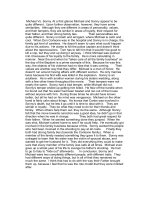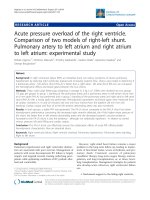Interchange of the degrees of comparison
Bạn đang xem bản rút gọn của tài liệu. Xem và tải ngay bản đầy đủ của tài liệu tại đây (13.2 KB, 1 trang )
Interchange of the degrees of comparison
It is possible to change the degree of comparison without changing the
meaning of a sentence. Study the following examples.
Positive: I am as strong as him.
Comparative: He is not stronger than me.
As you can probably see, both sentences mean the same.
Positive: No other girl in the class is as tall as Alice.
In the sentence given above a comparison is made between Alice and other
girls in her class using the positive adjective tall. The same idea can be
expressed using the comparative adjective taller and the superlative
adjective tallest.
Comparative: Alice is taller than any other girl in the class.
superlative: Alice is the tallest girl in the class.
More examples are given below:
Positive: No other metal is as precious as gold.
Comparative: Gold is more precious than any other metal.
Superlative: Gold is the most precious of all metals.
Superlative: India is the largest democracy in the world.
Comparative: India is larger than any other democracy in the world.
Positive: No other democracy in the world is as large as India.
Superlative: Susie is one of the cleverest girls in the class.
Comparative: Susie is cleverer than most other girls in the class.
Positive: Few girls in the class are as clever as Susie.
Notes
We use the comparative to compare one person, thing or group with another
person, thing etc. Therefore, the thing that is compared must be excluded
from the group of things with which it is compared. This is usually done by
using the word ‘other’.
Stay on top of your writing! Download our grammar guide from www.englishgrammar.org to stay up-to-date.
Powered by TCPDF (www.tcpdf.org)









